In: Niagara artists

Barry Smith | What’s Your Stance? | 2024
June 29, 2024Barry Smith | What’s Your Stance? | 2024
Barry Smith’s exhibition What’s Your Stance? was on view at Mahtay Café & Lounge in downtown St. Catharines for the majority of the month of May 2024 and into early June. Smith’s exhibition was the 18th in my continuing series of shows in the space platforming visual artists of the Niagara Region that is soon to mark two years.
Smith is not – on social media or in life – shy about his own ‘stance’ and his own political views. I’ve known him for most of my time in Niagara, and the exhibition is a series of images of photographers taking photos that Smith has captured in the act. There’s a voyeurism to the work, but the nature of the installation in the downtown St. Catharines space also allows play and interaction between the ‘characters’ as they seem to be taking pictures of each other, or are looking at people and events unknown and unseen to us.
Smith’s statement : Everyone has their opinions. Whether it be in the social, political or religious sphere. Some are based on fact, some on faith, and some are emotional due to personal experiences, education and (sadly) social media.
We all have a point of view. Some are balanced, conservative or outright risky.
I see this in the way people take photographs. Some are amateurs, some hobbyists and others are professional – but everyone has their own stance.
What’s your stance?
To say we live in a time when contention and division between peoples’ respective stances is intense is an understatement. Smith, for example, is a vocal advocate for Palestine and against the ongoing genocide perpetuated by the state of Israel and her enablers on the international scene. In our shared community – and many, many others – this is a ‘stance’ many of us see as being a default one, while others choose to stand somewhere else….
I often see things – I choose to stand, in my interpretation – through the lens of the art world, both in Canada (that imaginary nation we live in) and the larger international discourses within that sphere.
With the current situation in the Middle East, fractures – splits that expose or exacerbate hypocrisy – are becoming harder to deny. The termination of Wanda Nanibush from her position at the AGO, for example, spearheaded by someone who will allude to how art should have a social conscience and challenge us, but ‘just not that way’, or more exactly NOT in a way they ‘disagree’ with is a fine example.
I’d offer another : as many of you know, I spent nearly two decades in Saskatchewan, a place rife with racism regarding Indigenous and Settler relations. I was deeply amused – and not surprised at all – at the hypocrisy of someone I had the lamentable experience to work with in the ARC spaces publishing an article with Galleries West, decrying what he saw as ‘rising antisemitism’ in the international art world. This same person was instrumental in attempting to silence and blackball me when I published numerous factual articles about the institutional racism at his employer, the University of Saskatchewan, and I thought when I saw his blinkered whining that perhaps he had begun to see that dehumanizing others is not something that can be contained to one space, and bleeds into others, especially when you legitimize it for your own ideology, thinking it is ‘unique.’
Recently I read an engaging article from ArtForum about the rise in protests in museums and in gallery spaces and the writer – Charlotte Kent – offered a number of ideas and writers that I’ve been researching since I read the piece about how cultural spaces are stakeholders and often consistent – if not eager – manufacturers of alibis for the status quo, whether that status quo be that only one ‘type’ of art is ‘actually art’ or that some people and ideas are simply a denkverbot (to paraphrase Žižek) : of them, ‘we’ are ‘prohibited to speak.’
But, as Kent asserts ‘Museums [and by extension what fills them, as art] have never not been political.’
…I suspect I told you more about ‘my stance’ with that tangential response to Smith’s work than about his work, but I also suspect Smith would be comfortable with that, in that I ‘answered’ his question.
Born in Scotland and raised in Niagara, Barry Smith has always had a flair for humour and wit which he often employs in the titles of his photographs and his compositions. A self taught photographer, Smith has found his own unique photographic style and approach, concerned with using natural light. Smith’s photographs come to life like a fresh painting on canvas.
A past St. Catharines Art Award nominee, Smith’s pictures can be found on display throughout Niagara at various art shows and galleries.
What’s Your Stance? A Selection of Photographs by Barry Smith was on view at Mahtay Café & Lounge in downtown St. Catharines in the Spring of 2024.
You can see more of his work at his IG here.
~ Bart Gazzola
Read More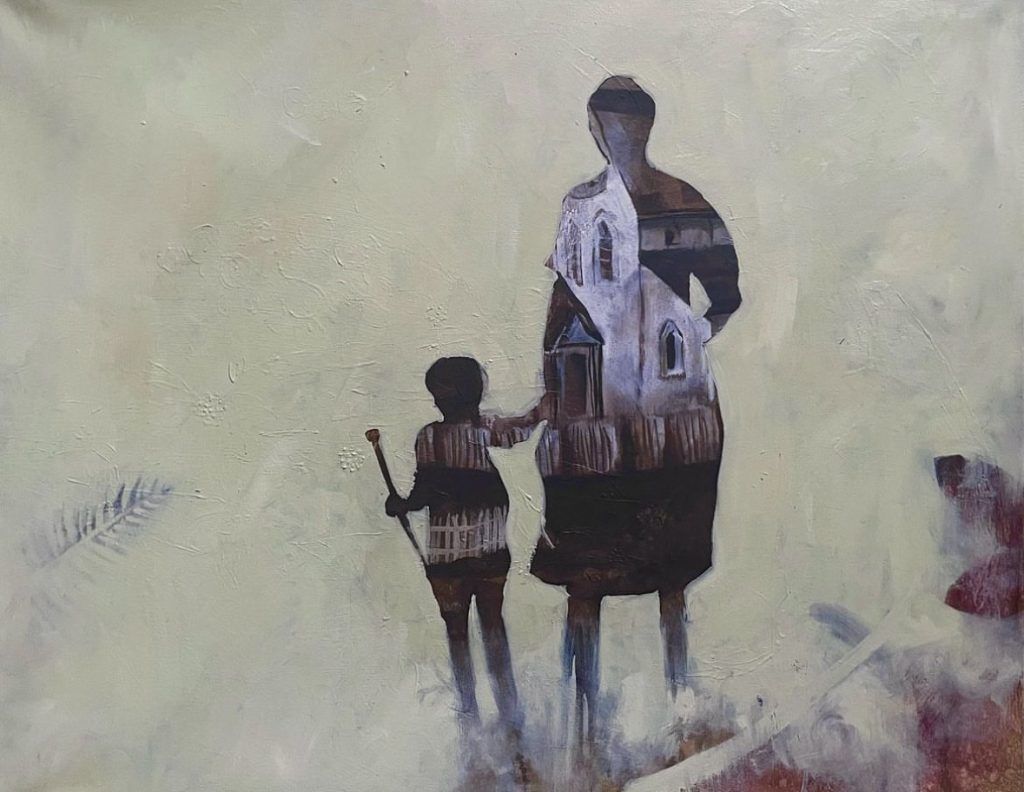
Curtis Doherty | Who Knit Ya? | 2024
February 25, 2024Curtis Doherty | Who Knit Ya? | 2024
February 20th to March 9th 2024 at Westland Gallery, London, Ontario
Out of these you make what you can, knowing that one thing leads to another. Sometime, someone will forget himself and say too much or else the corner of a picture will reveal the whole.
* * * * * * * * * * * * * * * *
I am alive in everything I touch. Touch these pages and you have me in your fingertips. We survive in one another. Everything lives forever. Believe it. Nothing dies.
* * * * * * * * * * * * * * * *
As the past moves under your fingertips, part of it crumbles. Other parts, you know you’ll never find. This is what you have.
(Timothy Findley, The Wars)
Mining family history in terms of artmaking is both a rich and a dangerous field. On this front, Amy Friends’ exhibition Assorted Boxes of Ordinary Life is a touchstone for me. In her exhibition, the assemblage – the editing, as to what might be revealed – of inherited objects that had significance that might be discerned by a visitor (others of which were opaque to an outsider) and the works that they inspired had a universal appeal. I say this as someone who has been exploring their ancestry in Niagara and found out some things that are also problematic (United Empire Loyalists as ancestors did not please me, ahem. I was comfortable with dissidents and criminals). Perhaps more of the ruminations of Timothy Findley is apropos here : “The occupants of memory have to be protected from strangers.”
In that same manner, Doherty presents a personal story that resonates with many of us, on many levels. Due to the locale – the sites he’s revisiting in paint being referential to Newfoundland, and the diaspora that has often been an experience of the people there, seeking work and economic stability far from home – the works of the late David Blackwood also come to mind, as an expansion of the conversation. One might see Blackwood’s works as one chapter of a story about Newfoundland, and Doherty’s as an addendum, decades later, but of the same ‘families.’
The artist statement :
“In 1930 a one-legged woman gathered all she had into a raggedy old chest and left Newfoundland for Quebec with her 6 year old son. Armfuls of photos, documents, and objects [lay] there for a century. What you are about to see is all of this brought to light [and] brought to life.
Witness the reality of the boy and his one-legged mother navigate the harsh landscape and time, the abandonment from the father, and the beauty of The Rock. The tangible and the intangible collide with areas of flat colour [so you must look] under the ribs of the wooden chest, to see the heart that lay under the ribs of the living chests.
“Who Knit Ya?” is a common Newfoundland term that asks who one’s parents are – a question this young boy asked his whole life. It begs to ask who we really are, and what legacy will we leave? It would be beyond folklore for anyone depicted here to imagine themselves captured in artworks a century later, and [moreso] what their toil paid forward. So as you view this work, be inspired to acknowledge the fact that we are just the tip of a larger iceberg, in a larger historical story. Ask yourself with introspection: WHO KNIT YA?”
I spoke to Doherty about his paintings (this new chapter added to family lore) after the reception for the exhibition, when conversations about the works led to wider considerations about the series. The words of the artist in conversation :
“It is a family story of mine…the small boy in the paintings is my grandfather, whose mother was the one legged woman, and whose father abandoned them.
There is also depictions of the mother’s parents (The Seal Hunter being her father- my great great grandfather). Through receiving this old trunk from my grandmother and all it’s neglected artifacts from 1880-1930, I’ve been able to piece together some family history, tell their story, and bring it to life from everything I found within that trunk. That was the trunk they moved to Quebec from Newfoundland with in 1929 / 30.
There are a few themes I’m touching on…stories of broken families, reconciliation of that brokenness, and lack of privilege and opportunity my grandfather had and [yet] still overcame it…And also just paying homage to hard working people of the past and the [amazing] thought [that] they could have never imagined they’d be depicted [and celebrated] in the future.”
In engaging with Doherty’s paintings, I’ve found myself looking through the lens of (appropriately) Canadian authors like Timothy Findley or Margaret Laurence whose characters are trying to make sense or discern a larger pattern of both their experiences or events that have defined their lives. This mirrors Doherty’s impetus for his paintings, and how sometimes the fragments are pushed together in a way that might not match the ‘reality’ but speak a contemporary truth to the descendants and inheritors of these objects and memories….
Now I am rampant with memory laments Hagar Shipley (from Margaret Laurence’s The Stone Angel) as in the declining days of her long existence she looks back on her life, in flashes both more intense and ‘real’ than her current state and often suffused with emotions both joyful and despairing. In some ways, she’s trying to reconcile conflicting and contested elements of a difficult story, just as we see in Doherty’s paintings, with his own family.
Doherty’s exhibition Who Knit Ya? – which the artist has subtitled ‘a vibrant exploration through a forgotten “new found land”‘ – is on view until March 9th, 2024 at Westland Gallery, London, Ontario. It’s presented in tandem with another exhibition titled Tales from the Rock (a group show of artists inspired by Newfoundland). I’ve relied heavily on literary references here in speaking to Doherty’s exhibition – and why not? It’s the stories we tell ourselves, or modify, as seen in Doherty’s paintings that define us. This is true even in the title of the show being a question that asks for similar stories from the viewers themselves : consider your lineage, and the people who defined and deformed you. Perhaps you see yourself as the latest link in a chain, or a break, instead.
Thus I am also comfortable to suggest you seek out David French’s play Leaving Home. It was one of the first stories I consumed, as a young man, about Newfoundland (though it takes place in Ontario – another parallel to Doherty’s paintings) that was not pure sentimentality but real and unflinching and difficult.
Although I have approached Doherty’s work while standing in the sphere of literature, I would indicate that when you look at his painting, that visual art has a significant advantage when exploring familial spaces with the inherent entanglements and contradictions: the multiplicity of interpretation, the possibility for injecting your own experiences into the works, is more rampant and possible. There is a vagueness – a subjectivity – to visual narratives that aligns with the vagaries of family history. The manner in which figures overlap and are constructed by other characters in the story acts as a visual depiction of how they are ‘knit’ from their ancestors. Some figures are just shadows in the background : and painting is the creation of a moment moreso than how photography is capturing one, and that is instrumental in what is presented here, which is perhaps dependent on facts but is also more demonstrative of feelings.
From his site : “Curtis Doherty is a Canadian painter who works primarily in oil who currently resides in Ontario. His work explores themes of history and the modern world through the complex relationship of the tangible and the intangible. He has studied at Sheridan College of Art & Design and abroad, as well as teaching at all levels.”
More of his work can be seen here.
The header image for this essay is titled Shule from the Scut : the images shared here are just a few selections from this series and were all created between 2019 and 2024. The full body of work can be enjoyed here.
Who Knit Ya? is on view at Westland Gallery (in London, Ontario) until the 9th of March 2024.
~ Bart Gazzola
Read More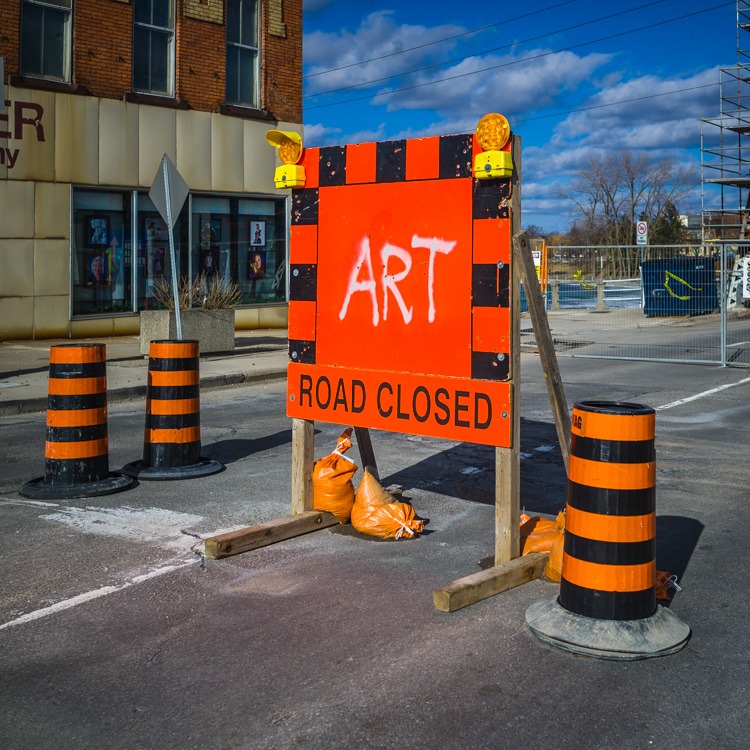
Sandy Fairbairn | ART, Road Closed | Welland, April 5 2014
January 19, 2024Sandy Fairbairn | ART, Road Closed | Welland, April 5 2014
Four years ago, just as Covid – 19 was beginning to move across the world, an exhibition of Sandy Fairbain‘s artworks that I curated at AIH Studios in Welland opened. These selections from the photographer’s extensive archive were focused upon the city of Welland and were collectively titled Welland : Times Present Times Past. Originally planned to run from February 15th to March 15th 2020, lockdowns and access became an issue, but I take joy in a local writer describing it as one of the most important exhibitions in that city, of the decade. There were also works that acknowledged the major role that Welland played in the history of labour rights in Canada, that were more sculptural, but that’s a story for another time (or seek out the book Union Power : Struggle and Solidarity in Niagara that is a fine history of the space, before we acquiesced to the ‘dogma’ of ‘trickle down economics’ and the liars Mulroney, Thatcher and Reagan, ahem).
This image was one of the more unique ones in that show, differing formally from Fairbairn’s usual straight on shots of buildings and edifices, reminiscent of ‘mug shot architecture’, if you will. But perhaps it might be better described as ‘morgue’ photos, as when we hung the show there were many captures of the same space, from decade to decade, and many times the sites were now demolished and empty….
I must add that as COVID took hold, I was in Welland for a longer time than I had planned to be there, with Fairbairn’s exhibition, and with the vagaries of lockdown I got to know the city late at night or early in the morning, a sense of itself that is not the ‘official’ kind.
Conceptually, this image offers both amusement and cynicism simultaneously. As someone who is soon to mark a decade of being part of the cultural community of Niagara, I could also add that it has resonance in terms of endeavours both planned and aborted, envisioned and stuttered, that have defined [and deformed] the cultural landscape of not just the city of Welland, but the larger Niagara Region.
So like any fine artwork, my interpretation of it changes depending upon when I see it, and the experiences I bring to it, and thus it shifts just as I do (perhaps in tandem, perhaps in opposition). To flip back to a more literal meaning from a conceptual one, my own attitudes about art initiatives within the space of Niagara have also changed, and spurred my decision to feature this work.
One hopes and works to foster artistic and cultural initiatives but finds the road closed, if you will. There are a variety of talks about ‘cultural revitalization plans’ in Niagara, but as this is the space that let a nationally recognized public art gallery go, with barely a whimper and now ignorant celebration of the ’boutique hotel’ that has taken it’s place, I shall reserve my enthusiasm…..but, to offer a positive point as we end, the push to have an Art Gallery of Welland is also moving forward, slowly but surely, and that effort is not without reward. As Sandy Fairbairn grew up in Welland (oh, the stories he’s shared with me, that I enjoy and enlivened some of his images from the aforementioned AIH exhibition), that is a space that might, soon, host more of his photographs like this one.
Not all roads are closed forever.
More of Sandy Fairbairn’s work can be seen here and here.
~ Bart Gazzola
Read More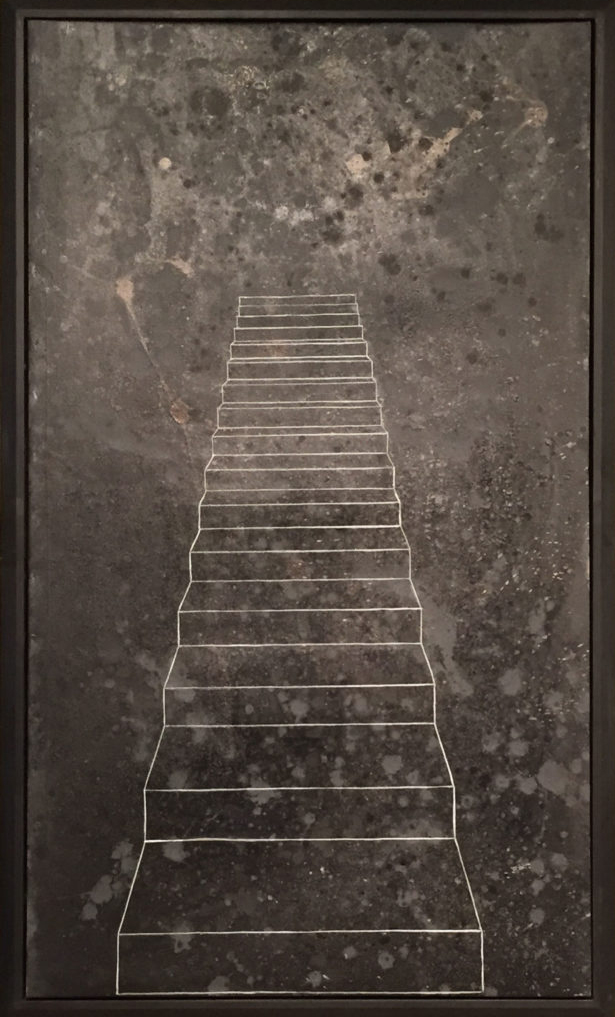
Ron Boaks | Stairway To The Heavens V | 2017
October 20, 2023Ron Boaks | Stairway To The Heavens V | 2017
There is a black which is old and a black which is fresh. Lustrous black and dull black, black in sunlight and black in shadow.
(Ad Reinhardt, from Art-as-art: The Selected Writings of Ad Reinhardt)
The dead cannot remember themselves; that’s why the living have to.
(Sarah Monette)
At the risk of getting too personal, too subjective, it’s often not a good experience to go to an art opening when you’re known in the community as an arts journalist. RM Vaughan has written about this, but there are – of course – exceptions to this rule, stepping outside the space where you have individuals attempting to bully and bleat or blow smoke up your ass, ahem.
When I was spending time in an exhibition of Ron Boaks’ painting a few years ago at a gallery in Niagara, an impromptu conversation with the artist became a high point of interaction and conversation about his work (and the larger milieu of artmaking, too).
At that time, Ron and I spoke about a body of work I colloquially refer to as the ‘Staircase’ series. These are (literally) darker works with an assortment of symbolic or metaphorical glyphs “scratched” and seemingly etched into and upon them : many of the pieces are defined by the recurring – but simple and perfect in execution – staircase. This offers an invitation to another site : not so much an ending as a transition to another place and sense of being.
Our conversation, at some point, touched upon how these were scenes Ron had created in response to the loss of loved ones : and I should clarify that they were dark in a formal sense but not in an experiential one. They had an element of hope, an injection of transcendence, perhaps, instead of a commentary on endings.
This painting that I’m featuring is from that exhibition and grouping of artworks : Boak’s Spirit Arise series.
Boaks’ words : “With this body of work, I am trying to capture “the lightness of being”, that essence of life, state of grace, of being alive right now. In 2013 two very dear people to me died. Awhile after their passing, I began to feel lighter in “spirit”, as, if they were now free, that it was OK for me to feel that too. This lightness is translated into these paintings as the energy or spirit entity, surrounded by rich colour. The paintings are grounded by the almost drafted line, measured, as it were, like distance markers on a map. X and Y coordinates are usually there, doubling as chromosomes. There are collaged bits, often as the pieces on each side edge that mark my boundaries. Balance and the interplay of opposites is as important as ever. Some of these paintings are serene and sublime while others are happy in their intensity or darkness. These are complex relationships made visible as simply as possible. These works need to be mulled over, absorbed and enjoyed.”
I would later visit Ron’s studio and we chatted about his work : I always love when artists trust me enough to invite me into their spaces, and I think that initial conversation had a role in that.
This is an image that offers a sense of what comes after death (and I say this as someone who is between an agnostic and an atheist, most days): but that which we leave behind us exists in a variety of forms, whether our experiences with others or the impressions we leave upon them, that inspire those whom remain to commemorate our passing.
Ronald Boaks’ career as an artist spans 30 + years. He has exhibited throughout Canada, the United States and the United Kingdom. His artwork has been widely collected and can be found in many public, corporate and private collections nationally and internationally.
More about his work can be seen here (Boaks was a previously featured Artist You Need To Know from AIH Studios’ continuing series) and at his site.
~ Bart Gazzola
Read More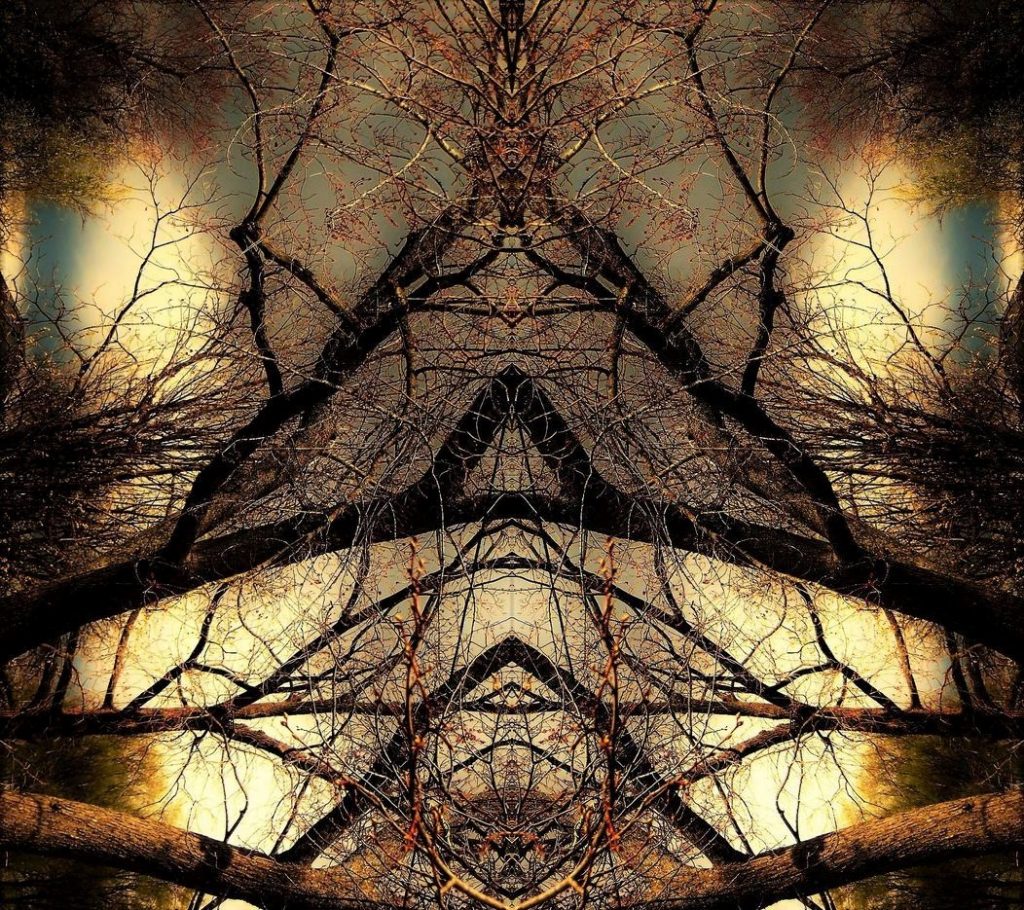
Diane Beard | Walking from the Darkness to the Light
October 2, 2023Diane Beard | Walking from the Darkness to the Light
“…life is brief and lovely, not long and foolish, that it is strange and beautiful, yeah as a dream, then so let it be, if it must be tears, if tears alone may serve…”
(Jack Kerouac)
Diane Beard is a photographer who takes pictures of her immediate community of Welland (usually while walking the streets of the city), often manipulating the images digitally to have a surreal or abstracted quality.
She was one of the featured artists in the Welland Creatives Network’ 13 on the 13th exhibition at the Welland Historical Museum in 2022. We became acquainted during COVID, when the artists’ group I facilitate – the 5 x 2 Visual Conversations – began to ‘meet’ online, and Beard was an enthusiastic and impressive participant.
Diane is the widow of artist Ross Beard (1953 – 2019) who was arguably the most significant visual artist in the history of the city of Welland. Frankly, I prefer to say ‘is’ as a recent exhibition of his work indicated that he lives on in his artwork and the joy many find within it.
His passing was – is – a fracture in her life, and part of her response has been the many images she’s produced and shared, both online and in the Niagara visual arts community.
From a recent exhibition – which was titled Walking from the Darkness to the Light – in St. Catharines : “Having been surrounded by Ross’s awe-inspiring art, sharing the same love of nature and appreciation for the Niagara area, driven by grief combined with a loss of identity after Ross’s passing, yet with no formal training, Diane began taking photographs as means to express her feelings and emotions. Diane’s sense of color and form transcends a simple mundane scene into something abstract and at times unrecognizable mimicking the profound change in her life.”
I’ve been lucky enough to talk with Diane often about her work. The contrast between a scene you recognize and something completely alien is one of the aspects of her work that’s alluring. Beard has an innate sense of colour, composition and a vibrancy in her scenes. This vivacity is an appropriate challenge to the fact that these images are, at their genesis, about loss and mourning and how to move through that….
Beard shares images regularly on social media, and is a prolific artist. I’ve only shared a small part of her body of work, and more can be enjoyed here and here.
~ Bart Gazzola
Read More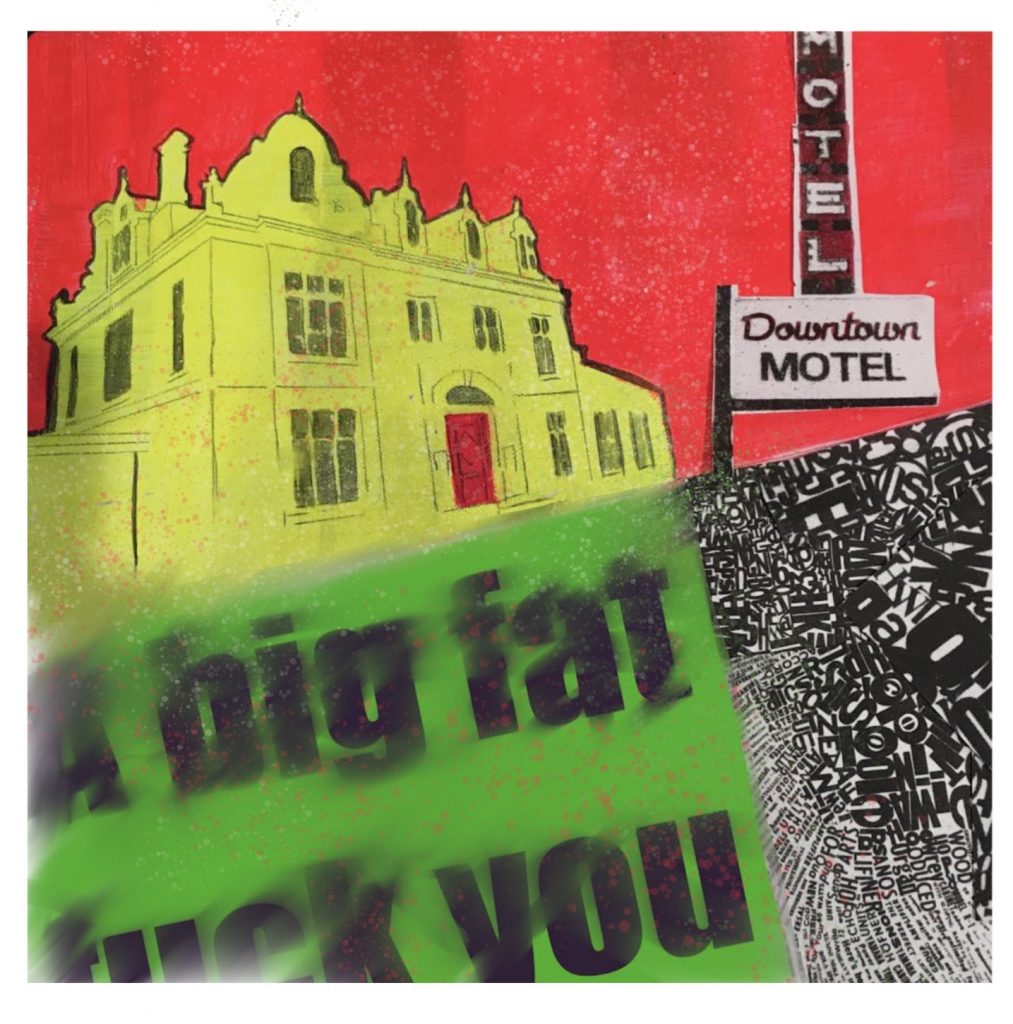
Liz Hayden | I dare you | 2022
September 24, 2023Liz Hayden | I dare you | 2022
“…the City’s refusal to support a public art gallery makes it’s endorsement of a heritage award a travesty.”
(Elizabeth Chitty)
A decade or so ago, I curated an exhibition from the archives of the now defunct (having merged into paved arts) Photographers Gallery in Saskatoon. On the accompanying panel (with artists Patrick Close, Sandra Semchuck and Doug Townsend, whom all had played seminal roles with the gallery as well as organizations like CARFAC and the Saskatchewan Arts Board) I made the observation that communities will create images of themselves that more accurately reflect the reality of the place, often when confronted with depictions that are not just disconnected from lived experience but in direct opposition to reality.
Liz Hayden’s image has been in my mind since she first shared it on social media some time ago : Hayden has been a vocal ally during the travails here in calling out the lies and self aggrandizing ignorance that has defined Brock University’s ‘demolition through neglect’ (to quote a past Cultural Coordinator for the city of St. Catharines) and sale of Rodman Hall Arts Centre, and the City of St. Catharines’ weathervaning between apathy and self congratulatory dishonesty.
The latest chapter in the travesty that is the City of St. Catharines’ apathy and ignorance – which has, in that manner I should know better by now, become even more egregiously foolish – was brought to my attention earlier this week. You can read more about that here. Essentially, the city council of St. Catharines – which I sometimes less than affectionately refer to as ‘North Welland’, to remind them that the delusion that STC is the ‘jewel’ of Niagara is a transparent lie to many of us in the cultural milieu – is seeking provincial heritage designation for the former gallery site, though it’s nothing more than a boutique hotel now, and all the things that made it an important site are now lost…
This is nothing more than STC Council giving an award to someone who has helped the local political cowards, miscreants, liars and ignorant incompetents NOT have to deal with the fact that the gallery may have been bulldozed and the subsequent critiques that would then expose their absence on the loss of the gallery and the harm this caused to the cultural community.
We used to have a nationally recognized and lauded art gallery, a centre for cultural and community oriented groups and now it’s just a ’boutique hotel’ and this merits recognition? This is an affront, especially considering the lackadaisical disinterest of the previous mayor and the inaction of many supposed ‘stakeholders.’
Did I mention that the city of St. Catharines has made some rumblings about wanting to have a ‘cultural renaissance’ in the city? Some things I cannot make up.
But now that I have set the stage with that intersecting rant, let us consider Liz Hayden’s artwork that speaks to these ideas. When we were speaking about it recently, she made the comment of ‘angry colours, wasted words.’
This work by Liz Hayden is titled I dare you : and I suspect that is a title that dares the viewer, but also those whom might be ‘offended’ by what the work states, to attempt to defend what has been allowed to happen, so their ignorance might be exposed. This is – like much of my writing and advocacy on the subject – perhps tilting at windmills : a recent ‘conversation’ on the Niagara History social media page was rife with people ‘excited’ at the new hotel, ignoring that access to the grounds would be limited, that a community focal point was gone, that citizens were irrelevant next to a few consumers and that this is a superficial facade that is a shoddy cover for what was an award winning artistic space that was deeply important to many.
These are some of the words that Hayden included to accompany another work in this series (which can be seen in the full post), but they are relevant here, as well :
Show me your garden and I shall tell you what you are. (Alfred Austin)
He is the gardener.
There at daybreak, he tills and waters: nurturing the plants, the community. Open-handed, he shares hard-gained knowledge and his harvest. Here is a place to heal, to grow. Free, in the air, without fear.
He is the gardener.
He walks the park, picking up.
Greets the old ladies, and their dogs, by name
A smile, the weather.
The garden is his purpose.
He toils there and grows
Himself and all of us
In that earth
This is one of a series of garden portraits I completed in 2022 focusing on gardens and gardeners here in St. Catharines, the Garden City. This acrylic on canvas portrays Richard Pierpont park, (previously known as Centennial Gardens) and Ross Hayden who has gardened there since the inception of those public gardens approximately 10 years ago.
A garden is a fine metaphor for a community : and there are many who are as insulted by the council’s proposal in terms of the loss of the green space as much as the artistic space. I will admit that I am also reminded of Oscar Wilde’s story about The Selfish Giant, but that one, at least, has a happy ending : but the giant had some introspection and that cannot be said for St. Catharine’s political ‘leaders’, on this front….
~ Bart Gazzola
Read More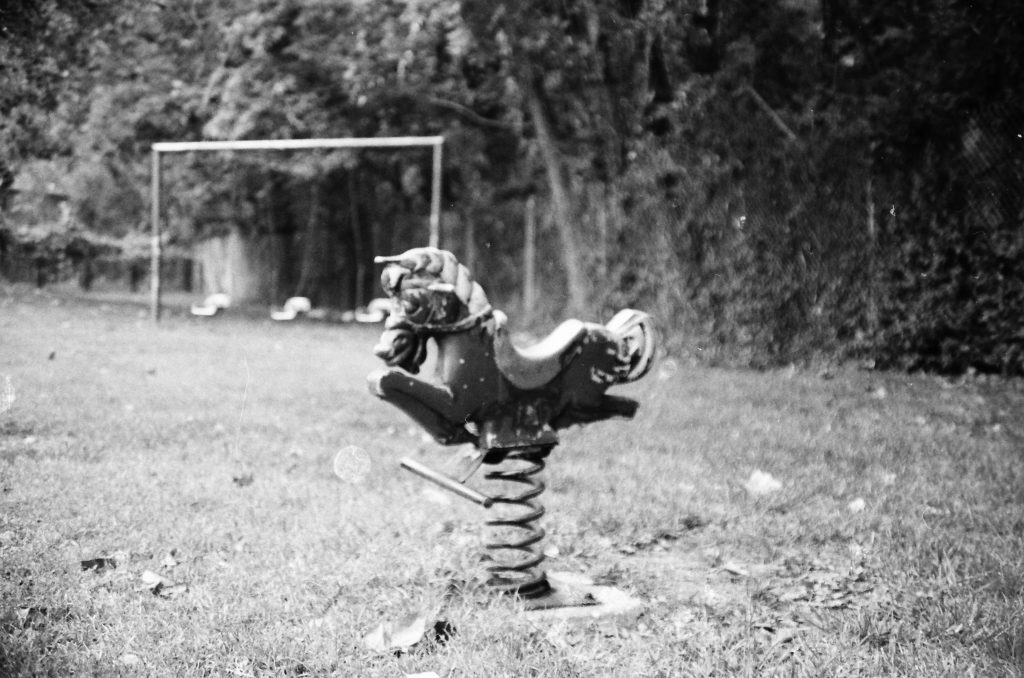
Chris Alic | Transience & Memory
September 16, 2023Chris Alic | Transience & Memory
One need not be a Chamber – to be Haunted –
One need not be a House –
The Brain has Corridors – surpassing
Material Place –
(Emily Dickinson)
The history of one who came too late
To the rooms of broken babies and their toys
Is all they talk about around here
And rebuke, did you think you’d be left out?
(Peter Straub, from Houses without Doors)
Like Mark Walton – and it’s a defining tenet of curated, I think – I also have a strong presence in my immediate and local visual arts community, with mine being Niagara : several of the artists I’ve featured here (Juliana D’Intino, for example, or Sandy Fairbairn) are ones that I’ve been lucky enough to include in a continuing curatorial project in downtown St. Catharines that began in Fall of 2022 and that is continuing indefinitely, with artists slated into late 2024.
Chris Alic is one of those artists, as her exhibition with Amber Lee Williams is currently on view at Mahtay Café & Lounge. That grew out of a 5 x 2 Visual Conversations evening (a relaxed sharing of art and ideas that I’ve facilitated for over five years, in St. Catharines and Welland). Like any good curator, I offered support to the two artists but primarily stayed out of the way, with some appropriate gentle nagging.
From that immediacy, let’s indulge some of my subjectivity that sparked my interest to consider these two pieces by Alic.
As the artist said when she spoke about the work, these are images from time she spent in Missouri in the United States – and, of late, I’ve fallen down another rabbit hole that centres upon the idea of the aesthetic of the Southern Gothic, whether that be in terms of crime or horror, but usually (and I own this) on the darker side. In light of this, the abandoned and lonely toys of Alic’s images take on a more ominous tone. Further clarification : I’ve been eschewing the ‘standard’ Southern Gothic horror of New Orleans, in my reading and research, but instead have been looking at other sites in the American South – like Charleston, or Alic’s Missouri – as these oft ignored sites have an unexplored richness in their stories that is more diverse than you might think. I also mention this – not just as another subjective indulgence – but because many of the stories I’m encountering in this enjoyable research are defined – or deformed – by the history of those sites (the institutional racism flows into the occult or supernatural horrors of the stories. There’s a story by Alan Moore about a television show that is shot on an old abandoned plantation where the filming somehow invokes the ghosts of the enslaved, and the actors ‘become’ their characters, with new manifestations of hate and racism being merged with old…all horror, they say, comes out of reality….or perhaps even the superficially banal, like Alic’s empty playground and abandoned tricycle….)
The words of the artist :
Memory is a huge part of what makes us human. Every interaction, every step, sight, sound, touch, smell – all these things create memory. But they are fragile. They are guided by perception, they are malleable, layered, are influenced by who we become, and who we become is in part made up of what we remember. Our memories continue to create us, and we create our memories. And we lose them. They fade, disintegrate, become suspect. They are subject to context, transformation and decay, and temporality, just like the spaces we inhabit and the things we use. They become the liminal space between an event and a feeling. Does emotion exist without memory?
I have been using a camera to secure my memories since I was a single-digit kid. I don’t remember ever not having a camera, or access to a camera. It was a part of my childhood, and everyone around me took photos and 8mm film of everyday life. My immediate and extended family were avid documentarians. I am continuing that tradition, but somewhere along the way I made the decision to “crop” those memories – to capture only small portions of context, little bits of an event, inexplicable to anyone but myself because each image is connected to an important moment, an emotion, a piece of who I became because of it. And then I edit. Adjust. Refine. Sometimes intentionally erase, fade, and transform them.
These seven images were made during a two-year period living in Columbia, Missouri. All were taken on a Yashica FX-70 Super 2000 film camera. I learned to use a darkroom and print my own photos with this film, and two of the images were only recently developed using caffenol-c. I had forgotten that I had taken the photos, I had forgotten the existence of the places until I saw them again.
The two person exhibition CHRIS ALIC & AMBER LEE WILLIAMS | TRANSIENCE OF MEMORY is on display at Mahtay Café & Lounge in downtown St. Catharines for the month of September, 2023.
~ Bart Gazzola
Read More
Julianna D’Intino | Connecting Rods: A Survey of Industry in the Niagara Region, 2015 – 2022
September 22, 2022Julianna D’Intino | Connecting Rods: A Survey of Industry in the Niagara Region, 2015 – 2022
To talk of the legacy of GM when you live in the city of St. Catharines is akin to how your tongue will always go to the gap in your teeth, seeking something that was there and now is not, leaving nothing behind but a perceptible absence you are unable to ignore.
Julianna D’Intino’s images, both moving and still – and I’ve been lucky enough to see several bodies of work she’s produced – often have a local focus, and in some ways she steps into that role of photographer as social historian. Often this involves her adjacent community in Niagara, exploring her own immediate heritage and circle. One such series can be seen here.
Connecting Rods: A Survey of Industry in the Niagara Region is a family story, as well as a local one. The ‘connection’ in the title of this series is not just a nod to an industrial interpretation, but also the families, communities and city that is part of a network that once had its epicenter in the abandoned wastelands D’Intino presents us with….and in her fine words about this series, D’Intino also draws connections to other areas with similar experience, such as with Atlas Steels or John Deere in Welland.
That potential for ‘nostalgia’ doesn’t mean what D’Intino is telling us is through rose – coloured glasses, nor does it gloss over the reality: her words about this work are as unflinching and honest – and engaging – as her photographs.
“This is but one personal case study in the myriad of lost industry of the Niagara Region. Would the return of the Niagara Region as a manufacturing hub provide a sustainable solution to the region’s economic woes? No, it would not. What is missing in the region is sufficient work at wages high enough to sustain a well-balanced life at the Niagara Region’s new inflated cost of living. The last time that such security was widespread was when manufacturing was a leading industry.”
The legacy of GM in St. Catharines is surely a contested narrative, with ground fertile for those from here – like D’Intino, or myself – to mine. It’s as rife as the industrial damage left behind at the site (an ongoing issue in civic politics here which has led to some grotesque and unsettling bedfellows), and there are differing opinions in play. Anna Szaflarski, for example, offers another perspective on this history here.
D’Intino’s site is here, and more images and D’Intino’s considered words about Connecting Rods can be found here.
~ Bart Gazzola
Read More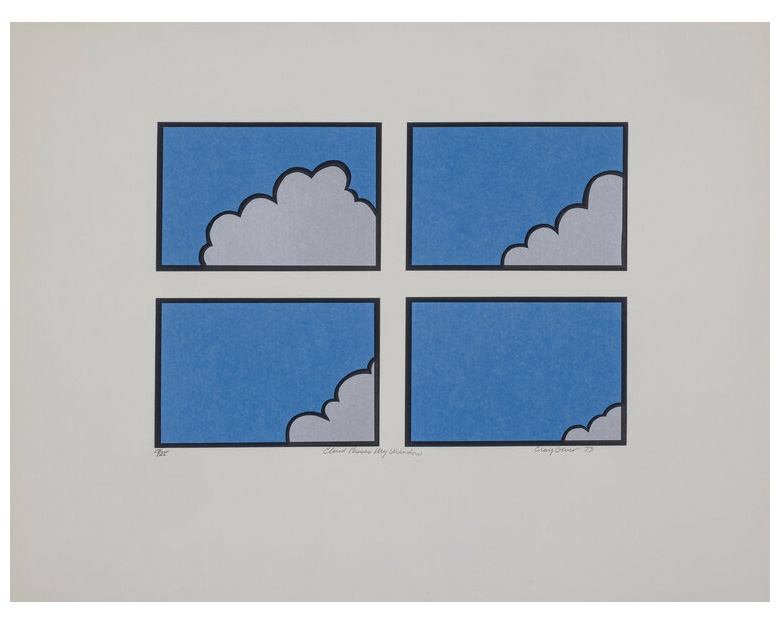
Craig Thomas Oliver | Cloud Passes My Window, 1973
September 15, 2022Craig Thomas Oliver | Cloud Passes My Window, 1973
Craig Thomas Oliver’s work always makes me melancholy. Perhaps it’s because not long after my return to Niagara I was approached to contribute an essay to an upcoming catalogue about the artist, published posthumously, as a means to bring attention to his art and accomplishments in Niagara. Later, I would include him in an exhibition I curated from the collection of Rodman Hall Art Centre, under the title of A Place To Stand, emphasizing artists in that archive who had built a place for others to grow and prosper within St. Catharines and Niagara. Both of those instances strike me as being about moments lost, or passing, with an implicit act of grieving.
Cloud Passes My Window is a small, delicate meditation, with clean, vibrant colours, like a sky so blue it might have been hammered into place. If you’ve visited Niagara Artists Centre (NAC) and their upstairs terrace – the CTO Terrace, named for Oliver, as a founding member of the artist run centre – this motif is familiar to you. On the left wall, a massive reproduction of Oliver’s simple and pristine white cloud on blue dominates the second storey space. It’s an amusing contrast, of the solidity of the architecture and the whimsical, ephemeral clouds, repeated like in this image: but in this work, it slowly leaves us, like any cloud – or person – who was here, and now gone.
I’ve spent many an evening there, with various NAC events, but I always think of it from a clear sunny afternoon, at the end of my first month upon returning to Niagara, in August of 2015. The CTO Terrace is a site often filled with music, so whenever I see any of Oliver’s ‘cloud’ works, Yoko Kanno’s song Blue comes to mind (Never seen a blue sky / Yeah I can feel it reaching out and moving closer
There’s something about blue / Asked myself what it’s all for / You know the funny thing about it / I couldn’t answer / No I couldn’t answer…)
Unsurprisingly, Kanno’s song may be about death, absence and loss, too. I’ve been told my mind goes to dark places, but that’s not entirely true, with the bright blue skies that Oliver shares with us, and that fills a wall in the loft space that bears his name, with ‘his’ sky to the side and the full sky above us…
But a more apropos element of textual ‘collage’ would be from Allen Ginsberg’s Elegy for Neal Cassady, written in the early morning hours (5 – 5:30 AM) upon learning of the passing of his friend and sometime lover:
aethereal Spirit
bright as moving air
blue as city dawn
happy as light released by the Day
over the city’s new buildings –
Lament in dawnlight’s not needed,
the world is released,
desire fulfilled, your history over,
story told, Karma resolved,
prayers completed
vision manifest, new consciousness fulfilled,
spirit returned in a circle,
world left standing empty, buses roaring through streets —
garbage scattered on pavements galore
Upon Oliver’s passing, NAC Director Stephen Remus offered the following tribute: “Craig was a key figure in the first wave of innovative collective projects that set the tone of wit and satire that has endured to define NAC today. [These include] the Niagara Now Billboard Exhibition (1972), Downtown Street Banner Project (1973), The Johnny Canuck Canadian Ego Exposition (1974), and The Johnny Canuck Canadian Ego Exhibitionist (1976). Craig was a master printmaker and he produced print work by many of his fellow NAC artists including John B. Boyle, Dennis Tourbin, Alice Crawley, and John Moffat.”
More about Oliver’s life and artwork can be read here.
~ Bart Gazzola
Read More
Necropolis | Jon Lepp
May 18, 2022Necropolis | Jon Lepp Necropolis | Jon Lepp, The Open for Business Series @deadendstories Photographs, [Virginia] Woolf claims, "are not an... Read More
Recent Comments